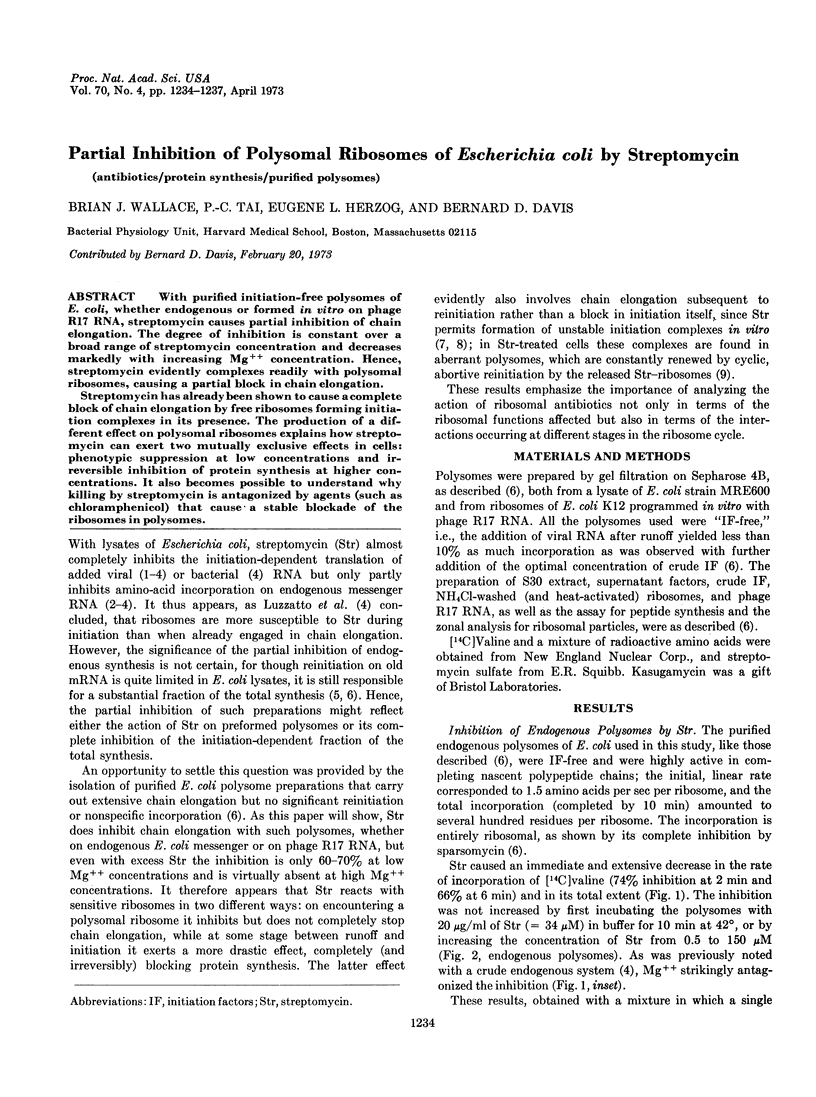Abstract
With purified initiation-free polysomes of E. coli, whether endogenous or formed in vitro on phage R17 RNA, streptomycin causes partial inhibition of chain elongation. The degree of inhibition is constant over a broad range of streptomycin concentration and decreases markedly with increasing Mg++ concentration. Hence, streptomycin evidently complexes readily with polysomal ribosomes, causing a partial block in chain elongation.
Streptomycin has already been shown to cause a complete block of chain elongation by free ribosomes forming initiation complexes in its presence. The production of a different effect on polysomal ribosomes explains how streptomycin can exert two mutually exclusive effects in cells: phenotypic suppression at low concentrations and irreversible inhibition of protein synthesis at higher concentrations. It also becomes possible to understand why killing by streptomycin is antagonized by agents (such as chloramphenicol) that cause a stable blockade of the ribosomes in polysomes.
Keywords: antibiotics, protein synthesis, purified polysomes
Full text
PDF



Selected References
These references are in PubMed. This may not be the complete list of references from this article.
- Capecchi M. R. Initiation of E. coli proteins. Proc Natl Acad Sci U S A. 1966 Jun;55(6):1517–1524. doi: 10.1073/pnas.55.6.1517. [DOI] [PMC free article] [PubMed] [Google Scholar]
- DAVIES J., GILBERT W., GORINI L. STREPTOMYCIN, SUPPRESSION, AND THE CODE. Proc Natl Acad Sci U S A. 1964 May;51:883–890. doi: 10.1073/pnas.51.5.883. [DOI] [PMC free article] [PubMed] [Google Scholar]
- Davies J., Gorini L., Davis B. D. Misreading of RNA codewords induced by aminoglycoside antibiotics. Mol Pharmacol. 1965 Jul;1(1):93–106. [PubMed] [Google Scholar]
- García-Patrone M., Perazzolo C. A., Baralle F., González N. S., Algranati I. D. Studies on dissociation factor of bacterial ribosomes: effect of antibiotics. Biochim Biophys Acta. 1971 Aug 26;246(2):291–299. doi: 10.1016/0005-2787(71)90139-0. [DOI] [PubMed] [Google Scholar]
- Herzog A., Ghysen A., Bollen A. Sensitivity and resistance to streptomycin in relation with factor-mediated dissociation of ribosomes. FEBS Lett. 1971 Jul 1;15(4):291–294. doi: 10.1016/0014-5793(71)80640-3. [DOI] [PubMed] [Google Scholar]
- Lelong J. C., Gros D., Cousin M. A., Grunberg-Manago M., Gros F. Streptomycin induced release of fMet-tRNA from the ribosomal initiation complex. Biochem Biophys Res Commun. 1971 Feb 5;42(3):530–537. doi: 10.1016/0006-291x(71)90403-7. [DOI] [PubMed] [Google Scholar]
- Luzzatto L., Apirion D., Schlessinger D. Mechanism of action of streptomycin in E. coli: interruption of the ribosome cycle at the initiation of protein synthesis. Proc Natl Acad Sci U S A. 1968 Jul;60(3):873–880. doi: 10.1073/pnas.60.3.873. [DOI] [PMC free article] [PubMed] [Google Scholar]
- Luzzatto L., Apirion D., Schlessinger D. Streptomycin action: greater inhibition of Escherichia coli ribosome function with exogenous than with endogenous messenger ribonucleic acid. J Bacteriol. 1969 Jul;99(1):206–209. doi: 10.1128/jb.99.1.206-209.1969. [DOI] [PMC free article] [PubMed] [Google Scholar]
- Modolell J., Davis B. D. Breakdown by streptomycin of initiation complexes formed on ribosomes of Escherichia coli. Proc Natl Acad Sci U S A. 1970 Nov;67(3):1148–1155. doi: 10.1073/pnas.67.3.1148. [DOI] [PMC free article] [PubMed] [Google Scholar]
- Modolell J., Davis B. D. Mechanism of inhibition of ribosomes by streptomycin. Nature. 1969 Oct 25;224(5217):345–348. doi: 10.1038/224345a0. [DOI] [PubMed] [Google Scholar]
- Modolell J., Davis B. D. Rapid inhibition of polypeptide chain extension by streptomycin. Proc Natl Acad Sci U S A. 1968 Dec;61(4):1279–1286. doi: 10.1073/pnas.61.4.1279. [DOI] [PMC free article] [PubMed] [Google Scholar]
- Okuyama A., Machiyama N., Kinoshita T., Tanaka N. Inhibition by kasugamycin of initiation complex formation on 30S ribosomes. Biochem Biophys Res Commun. 1971 Apr 2;43(1):196–199. doi: 10.1016/s0006-291x(71)80106-7. [DOI] [PubMed] [Google Scholar]
- Ozaki M., Mizushima S., Nomura M. Identification and functional characterization of the protein controlled by the streptomycin-resistant locus in E. coli. Nature. 1969 Apr 26;222(5191):333–339. doi: 10.1038/222333a0. [DOI] [PubMed] [Google Scholar]
- PLOTZ P. H., DAVIS B. D. Absence of a chloramphenicol-insensitive phase of streptomycin action. J Bacteriol. 1962 Apr;83:802–805. doi: 10.1128/jb.83.4.802-805.1962. [DOI] [PMC free article] [PubMed] [Google Scholar]
- SZER W., OCHOA S. COMPLEXING ABILITY AND CODING PROPERTIES OF SYNTHETIC POLYNUCLEOTIDES. J Mol Biol. 1964 Jun;8:823–834. doi: 10.1016/s0022-2836(64)80163-7. [DOI] [PubMed] [Google Scholar]
- Tai P. C., Wallace B. J., Davis B. D. Actions of aurintricarboxylate, kasugamycin, and pactamycin on Escherichia coli polysomes. Biochemistry. 1973 Feb;12(4):616–620. doi: 10.1021/bi00728a008. [DOI] [PubMed] [Google Scholar]
- Tai P. C., Wallace B. J., Herzog E. L., Davis B. D. Properties of initiation-free polysomes of Escherichia coli. Biochemistry. 1973 Feb;12(4):609–615. doi: 10.1021/bi00728a007. [DOI] [PubMed] [Google Scholar]
- WHITE J. R., WHITE H. L. STREPTOMYCINOID ANTIBIOTICS: SYNERGISM BY PUROMYCIN. Science. 1964 Nov 6;146(3645):772–774. doi: 10.1126/science.146.3645.772. [DOI] [PubMed] [Google Scholar]
- YAMAKI H., TANAKA N. EFFECTS OF PROTEIN SYNTHESIS INHIBITORS ON THE LETHAL ACTION OF KANAMYCIN AND STREPTOMYCIN. J Antibiot (Tokyo) 1963 Nov;16:222–226. [PubMed] [Google Scholar]


